Considered the most striking of the quartz family, amethyst has always been coveted.
Queen Catherine the Great was a great admirer of this gemstone.
For a long time it was considered as precious as sapphires, diamonds and emeralds.
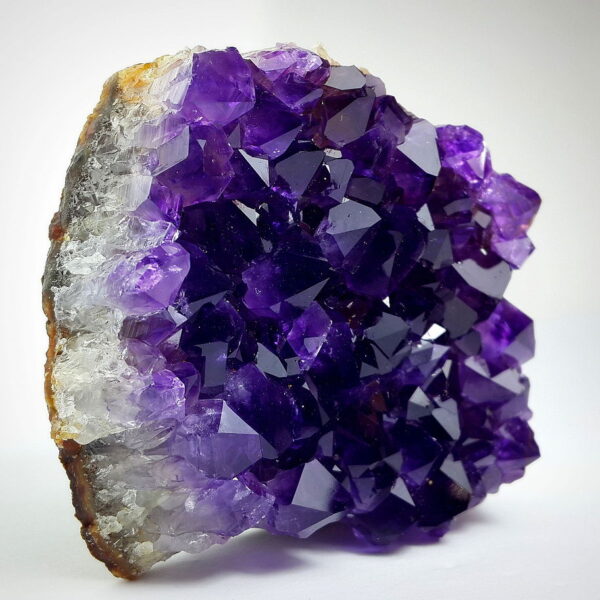
Today, with the discovery of abundant deposits, it is no longer as valuable.
Its value has diminished – but its seductive beauty remains.
The violet or purple variety of quartz, the amethyst, was not only widely used as a gemstone until the 18th century, it also has an aura of mysticism.
Many ‘powers’ are attributed to it in different cultures. Some say that the name amethyst comes from the ancient belief that the stone protected its owner from drunkenness.
The name amethyst comes from the Greek word “amethuskein”, where the “a” means no and the “methuskein” means intoxicate.
However, the origin of the name is controversial.
Its colour comes from the presence of iron impurities and traces of aluminium, and some varieties are coloured by exposure to radiation.
The colours vary from purple or light purple to dark, with the darker, more transparent ones being more prized and therefore more expensive.
Some can change colour completely when heat-treated, as you’ll see below.
Amethyst does not have a uniform colour distribution. It appears in fragments, in uneven and/or outer corners.
This characteristic often dictates the type of cut to make the most of the gem and increase its value.
Amethysts with perfect colour distribution are very rare and, when found, very expensive.
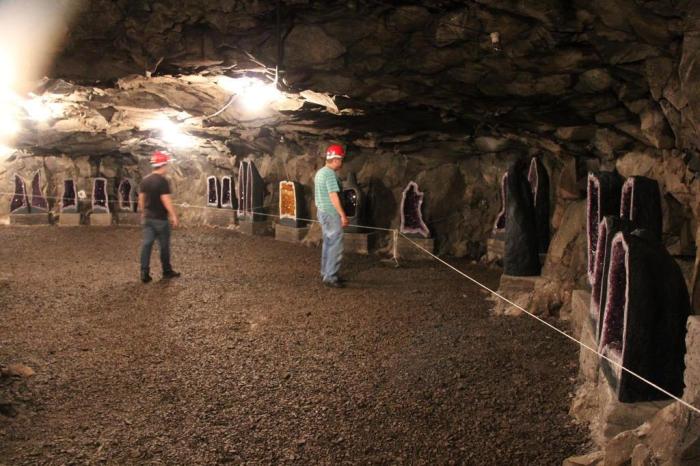
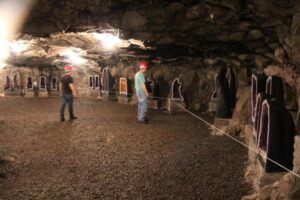
A terra das pedras preciosas gigantes Ametista do Sul 11:25
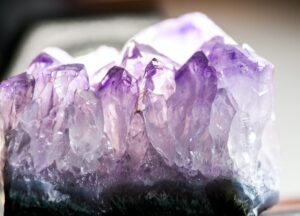
Ametista - Caracteristicas, Comercialização e Avaliação09:18

O processo de extração da pedra Ametista04:34
Amethysts
1. Gemological characteristics
- Mineral class: quartz
- Crystal system: trigonal; hexagonal prisms
- Chemical formula: SiO2
- Hardness: 7 Mohs
- Density: 2.63 – 2.65
- Transparency: Transparent to translucent
- Colour: violet, purple, light to dark purple
- Lustre: glassy
- Fluorescence: weak or absent
- Fracture: conchoidal, brittle
Amethyst is made up of an irregular overlap of alternating layers of quartz on the left and right sides.
As a result of this formation, amethyst can fracture with a wavy fracture or show “fingerprints”.
Some mineralogists apply the name amethyst to any quartz that shows this structure, regardless of its colour. The crystals always grow on a base.
When they are pyramid shaped, the most intense colour is at the top of these crystals.
There are some varieties of amethyst that can have white bands of milky quartz.
Amethysts are mainly found in the crystallised crusts of giant volcanic rocks such as basalt.
2. Commercialisation
Amethysts are sold in abundance and at very reasonable prices, but the most beautiful and valuable varieties are found in only a few places.
These have a deeper purple or violet colour.
The main deposits are in Brazil, but only about 3% of Brazilian amethysts are suitable for cutting and use in jewellery.
The rest are used to make citrine and are also used for decoration or collections. Other important deposits are found in Uruguay, India, Russia, Sri Lanka, Madagascar and the United States.
Argentina, Bolivia, Mexico, Namibia, Zambia, South Africa and Canada are also amethyst producers.
Because they come in different colours and shades, they are often named after their country of origin, e.g. Brazilian amethyst, Bolivian amethyst, etc.
3. Grading
We’ve already talked about the 4C’s of diamond grading.
Although it is a grading standard set by the GIA (Gemological Institute of America) for diamonds, it is the most widely accepted in the world and is widely used for other gemstones as well as by various laboratories, gemologists and appraisers.
Colour, Carat, Clarity and Cut are the 4C’s that are also used to grade amethysts.
- Colour
The most valuable amethysts have a strong red-violet colour and no colour zoning, i.e. the colour is evenly distributed throughout the stone. Very dark amethysts are not as valuable because the brightness is greatly reduced.
The presence of brown or bronze tones in amethysts also reduces their value. In order to detect some colour zoning with the naked eye, buyers usually place the amethyst on a table with a white surface.
- Clarity
Inclusions are one of the factors that determine the clarity of an amethyst. The smaller the number of inclusions, the higher the value and the better the grade.
Most faceted amethysts on the market don’t have inclusions that are visible to the naked eye, but they are present in the vast majority of them. Fractures are also common.
- Weight and size
The weight of this gemstone is measured in carats. Like most gemstones, amethysts come in a range of sizes and are measured in millimetres.
Large centre stones are commonly used and sold in jewellery shops as long as the final price isn’t too high.
- Cutting and Polishing
As we’ve said before, most amethysts are faceted to make better use of the colour distribution and also to minimise inclusions.
If these inclusions are very visible, they are cut into small cabochons or beads.
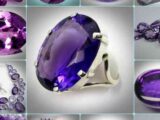
Ovals, pears, emerald cuts, triangular cuts, marquise cuts and cushion cuts are all common.
Some arrangements and combinations of cuts appear in this gemstone, such as step cuts and mixed faceted cuts. There are also a variety of cuts called fantasy cuts, which have certain concave facets – these are usually mass-produced for specific collections.
Even animal sculptures are made with amethysts. In practice, amethysts are valued for their colour and clarity. Due to the high supply, demand is decreasing, making it a relatively cheap and easy gem to buy.
However, amethysts never go out of fashion and are always present in expensive jewellery as well as cheaper pieces.
4. Colour varieties
Amethysts come in a wide variety of colours depending on where they are found.
Those from Uruguay and Arizona have a deep purple-blue colour.
Amethysts from Russia are known as “Siberian” and have very deep colours with reddish and bluish tones.
They come from depleted deposits and therefore command a higher price.
Africa produces amethysts with deeper colours than Brazil and other South American countries.
The term African amethyst can be used to refer to amethysts with different shades or darker colours, but it doesn’t always mean that this is their origin.
Brazil is considered the largest producer of amethysts, although most Brazilian amethysts are treated and sold as heated citrines. Here the stones are available in all shapes and sizes.
The colours are not as good as in Africa, but they meet the market demand.
5. Treatments and synthetics
Heat treatment can be used to lighten the colour of very dark amethysts, darken light amethysts or remove brownish inclusions.
Ultraviolet radiation is also used to enhance or change the colour of amethysts.
Fracture treatments are rarely used due to the high availability of specimens that do not show fractures to the naked eye.
Heat treatment causes inclusions to expand, which can lead to fractures in the gem, and it also increases the effect of colour zoning.
Normally, inclusions and zoning expansions are used to distinguish a treated amethyst from an untreated or synthetic amethyst.

When amethyst is heated to high temperatures, around 470ºC to 750ºC, the iron impurities are reduced, resulting in heated citrine.
Although this treatment is common, the colour obtained from citrine is not always permanent.
Citrine, also called citrine quartz (there are several other incorrect names, such as citrine topaz), is a variety of quartz with a yellow, orange and, exceptionally, a red colour. Basically it’s quartz with iron impurities.Most commercial citrine is actually amethyst or artificially heated smoky quartz.
However, the heat-treated stone can have differences, including a pinker colour characteristic of the original stone. However, the commercial value is the same, at least in Brazil. Citrine quartz is a low-cost gemstone, less expensive than amethyst, but still highly prized and widely used in jewellery. Brazil and Scotland are the world’s largest producers of citrine. Brazil is the leading producer of amethyst, rose quartz and colourless quartz, with much of the production coming from Rio Grande do Sul. This variety of quartz is often used as a substitute for many yellow gemstones, such as topaz or sapphire.
Synthetic amethysts can be produced by hydrothermal methods, in which small fragments of quartz and a solution of calcium carbonate, for example, are placed in a sealed container under high pressure.
This causes the crystals to fuse and recrystallise when heated.
Some gem experts say that synthetic amethysts are widely mixed with natural amethysts on the market, but as identification tests – in their case – are not widely used, they can’t say for sure.
Others say that the supply is so great that the production of synthetic amethysts is limited to use in radios, watches and other electrical appliances.
Therapeutic properties
In the past, amethyst was often used to protect people from drunkenness and intoxication, hence its name.
Today amethysts are worn to keep faith, bring peace and calm the mind. It is said to increase wisdom and religiosity.
It prevents evil thoughts and actions, gives sensitivity in business and good health.
Oriental women wear it on their foreheads and believe it gives positive energy to the Ajna chakra, also known as the ‘third eye’.
Caring for
Amethyst is a very durable stone, but care should be taken to remove jewellery during activities where the stone may be scratched.
It is important to avoid prolonged exposure to intense sunlight, radiation or black light. It can be easily cleaned with warm water and neutral soap, using a soft cloth or toothbrush. When storing, take care not to place it next to other harder stones, as scratches are inevitable.
Do not use any chemical or abrasive products. Ideally, it should be wrapped in a soft cloth or a fabric-lined box.
Publicações Relacionadas
Tiger Eye Stone - Characteristics and Cutting
Diamonds have 4 basic classifications, weight, colour, purity and cut
The malachite stone is a distinctive gemstone - Features
Aquamarine Stone is used in the jewellery industry - characteristics
Emerald Stone - Characteristics, varieties and quality
Ruby Stone - Characteristics, Colours and Cutting
Sapphire is the purity of nature and a symbol of honesty
Jewellery made from different types of coral - Features
Quartz Stone - Characteristics, Colours and Varieties
Identifying a gem is a difficult task
Jade stone - characteristics, colour, classification and cutting
Opala é uma das mais belas pedras preciosas encontradas no Brasil
Characteristics of the Paraíba Tourmaline, a rare gemstone
Tourmaline: Learn about its characteristics and varieties
Pindobaçu (BA), known as the capital of emeralds
Agate Stone - Characteristics, Types, Colour and Cutting
Characteristics of Topaz and Imperial Topaz gemstones
This post is also on:
![]() Português
Português ![]() English
English ![]() Deutsch
Deutsch ![]() Español
Español ![]() Français
Français



















